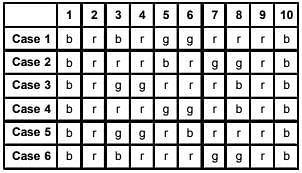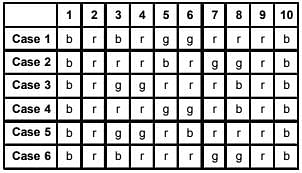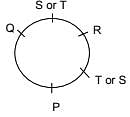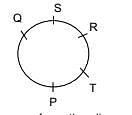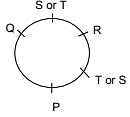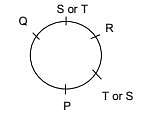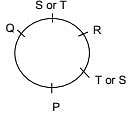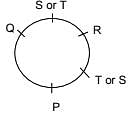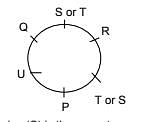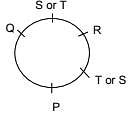Test: Seating Arrangement - CAT MCQ
9 Questions MCQ Test - Test: Seating Arrangement
Each of the 10 persons namely A, Q, R, Z, M, N, P, B, K and L are wearing a shirt. The colour of each shirt is one out of blue, green and red. There are ten chairs placed in a row. The chairs are consecutively numbered 1, 2, 3, 4...9 and 10 from left to right in that order. These ten persons have to sit on the chairs such that there is only one person in each chair. The number of persons wearing a green and a blue shirt is 2 and 3 respectively.
Additional Information:
1. No two persons wearing blue shirts sit on consecutively numbered chairs.
2. Among the persons wearing red shirts, exactly three persons always are sitting together while the remaining two never.
3. A person wearing a blue shirt and a person wearing a green shirt never is sitting on
consecutively numbered chairs.
4. A person wearing a green shirt cannot sit on chairs numbered 2 or 9.
5. Persons wearing red shirts are not sitting at extreme ends.
The following table provides information about the six different seating arrangements namely I, II, III, IV, V and VI of the ten persons done by Mr. Crazy. He observed that out of all the seating arrangements done by him, there is one arrangement that is not consistent with the information stated under "Additional Information".

Q. Which of the arrangements done by Mr. Crazy is not consistent with the information stated under "Additional Information"?

Each of the 10 persons namely A, Q, R, Z, M, N, P, B, K and L are wearing a shirt. The colour of each shirt is one out of blue, green and red. There are ten chairs placed in a row. The chairs are consecutively numbered 1, 2, 3, 4...9 and 10 from left to right in that order. These ten persons have to sit on the chairs such that there is only one person in each chair. The number of persons wearing a green and a blue shirt is 2 and 3 respectively.
Additional Information:
1. No two persons wearing blue shirts sit on consecutively numbered chairs.
2. Among the persons wearing red shirts, exactly three persons always are sitting together while the remaining two never.
3. A person wearing a blue shirt and a person wearing a green shirt never is sitting on
consecutively numbered chairs.
4. A person wearing a green shirt cannot sit on chairs numbered 2 or 9.
5. Persons wearing red shirts are not sitting at extreme ends.
The following table provides information about the six different seating arrangements namely I, II, III, IV, V and VI of the ten persons done by Mr. Crazy. He observed that out of all the seating arrangements done by him, there is one arrangement that is not consistent with the information stated under "Additional Information".
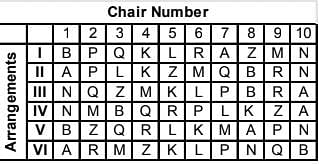
Q. Which of the following persons is wearing a blue shirt?

| 1 Crore+ students have signed up on EduRev. Have you? Download the App |
Each of the 10 persons namely A, Q, R, Z, M, N, P, B, K and L are wearing a shirt. The colour of each shirt is one out of blue, green and red. There are ten chairs placed in a row. The chairs are consecutively numbered 1, 2, 3, 4...9 and 10 from left to right in that order. These ten persons have to sit on the chairs such that there is only one person in each chair. The number of persons wearing a green and a blue shirt is 2 and 3 respectively.
Additional Information:
1. No two persons wearing blue shirts sit on consecutively numbered chairs.
2. Among the persons wearing red shirts, exactly three persons always are sitting together while the remaining two never.
3. A person wearing a blue shirt and a person wearing a green shirt never is sitting on
consecutively numbered chairs.
4. A person wearing a green shirt cannot sit on chairs numbered 2 or 9.
5. Persons wearing red shirts are not sitting at extreme ends.
The following table provides information about the six different seating arrangements namely I, II, III, IV, V and VI of the ten persons done by Mr. Crazy. He observed that out of all the seating arrangements done by him, there is one arrangement that is not consistent with the information stated under "Additional Information".
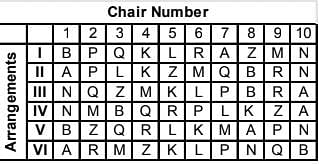
Which of the following persons is wearing a green shirt?

Each of the 10 persons namely A, Q, R, Z, M, N, P, B, K and L are wearing a shirt. The colour of each shirt is one out of blue, green and red. There are ten chairs placed in a row. The chairs are consecutively numbered 1, 2, 3, 4...9 and 10 from left to right in that order. These ten persons have to sit on the chairs such that there is only one person in each chair. The number of persons wearing a green and a blue shirt is 2 and 3 respectively.
Additional Information:
1. No two persons wearing blue shirts sit on consecutively numbered chairs.
2. Among the persons wearing red shirts, exactly three persons always are sitting together while the remaining two never.
3. A person wearing a blue shirt and a person wearing a green shirt never is sitting on
consecutively numbered chairs.
4. A person wearing a green shirt cannot sit on chairs numbered 2 or 9.
5. Persons wearing red shirts are not sitting at extreme ends.
The following table provides information about the six different seating arrangements namely I, II, III, IV, V and VI of the ten persons done by Mr. Crazy. He observed that out of all the seating arrangements done by him, there is one arrangement that is not consistent with the information stated under "Additional Information".
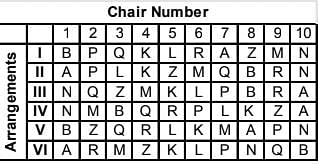
Q. Which of the following is not a permissible group of four persons such that the number of persons wearing a red, a green and a blue shirt is 2, 1 and 1 respectively?
These questions are based on the following information. P, Q, R, S and T sit around a table. P sits two seats to the left of R and Q sits two seats to the right of R.
Q. If S sits in between Q and R, who sits to the immediate right of P?
These questions are based on the following information. P, Q, R, S and T sit around a table. P sits two seats to the left of R and Q sits two seats to the right of R.
Q. Which of the following cannot be the correct seating arrangement of the five persons in either the clockwise direction or the anti-clockwise direction?
These questions are based on the following information. P, Q, R, S and T sit around a table. P sits two seats to the left of R and Q sits two seats to the right of R.
Q. If S is not sitting next to Q, who is sitting between Q and S?
These questions are based on the following information. P, Q, R, S and T sit around a table. P sits two seats to the left of R and Q sits two seats to the right of R.
Q. If a new person U joins the group such that the initial conditions for the seating arrangement should be observed and also a new condition that U does not sit next to R be satisfied, then which of the following statements is true?
These questions are based on the following information. P, Q, R, S and T sit around a table. P sits two seats to the left of R and Q sits two seats to the right of R.
Q. If a new person U joins the group such that the initial conditions for the seating arrangement should be observed and also a new condition that U does not sit next to P, S or T be satisfied, then who will be the neighbours of P (one on either side)?



